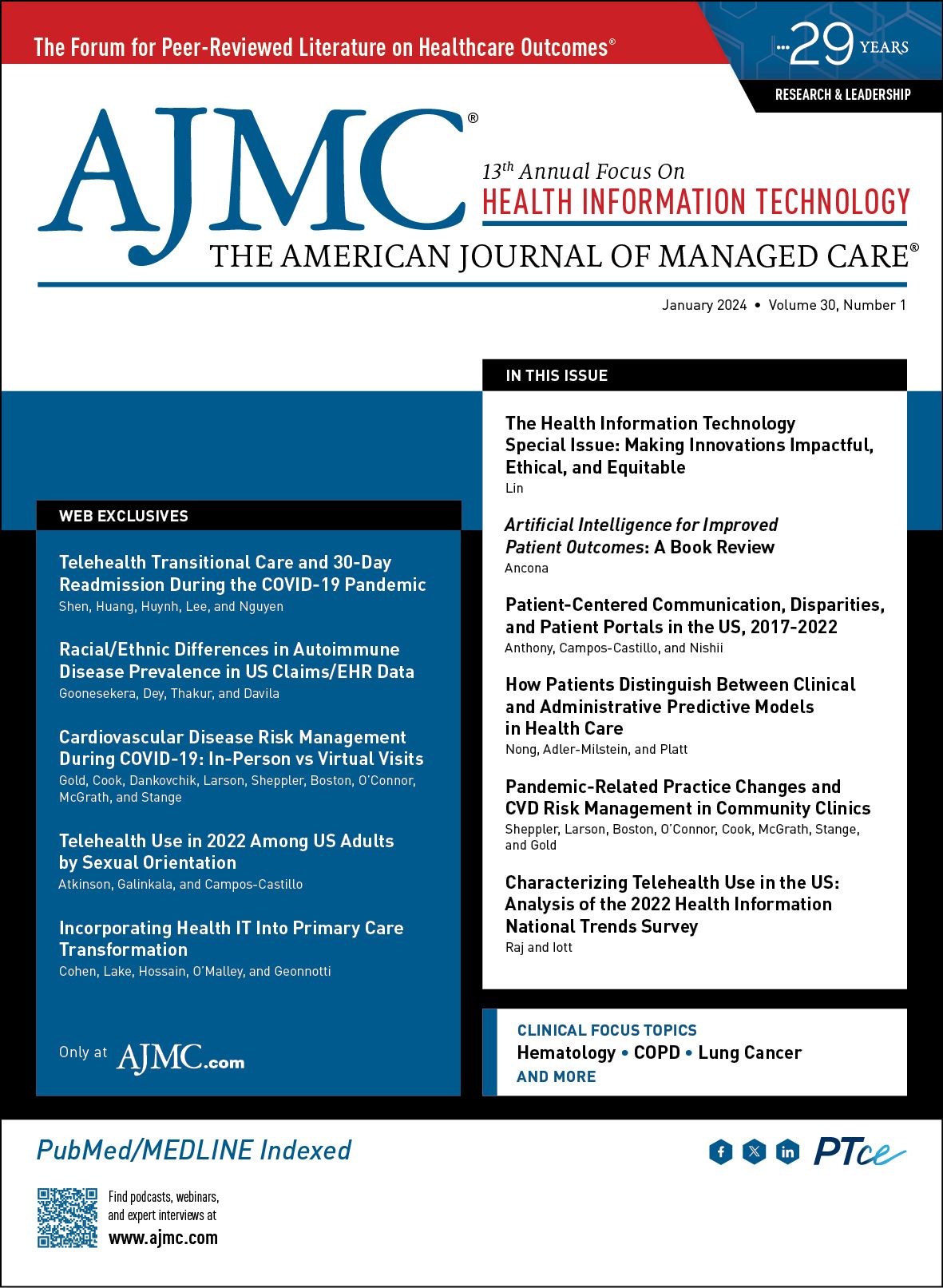Publication
Article
The American Journal of Managed Care
The Health Information Technology Special Issue: Making Innovations Impactful, Ethical, and Equitable
Author(s):
A letter from the guest editor highlights how the findings in this special issue draw attention to critical questions that have arisen from health care’s digital transformation.
Am J Manag Care. 2024;30(1):15-16. https://doi.org/10.37765/ajmc.2024.89481
The age of the Internet of Things has facilitated greater levels of information connectivity than ever before, stimulating data collection on an unprecedented scale and pushing the boundaries on what computer-assisted automation, decision-making, and personalization can do for health care delivery. However, the digital transformation of our health care system also comes at a cost. Recent innovations in health information technology (HIT) have blurred the boundaries between work and life, raised the burden of clinician documentation, and made it easier to weave social bias into the operational DNA of our medical institutions. The American Journal of Managed Care’s 13th annual HIT special issue—to be published in 2 parts, both this issue and a second part coming this spring—features approximately 20 articles that further our understanding of how HIT can be used to support health care delivery and raise critical questions about how to center humanity amid rapid technological advancement. These articles cover 3 important areas of HIT growth: (1) virtual medicine, (2) artificial intelligence (AI) and other algorithms, and (3) the use of electronic health records (EHRs).
Virtual Care
In 2020, the COVID-19 pandemic led to widespread use of virtual modalities to deliver health care, including telehealth, video visits, and patient portals. As the urgency to isolate fades from public consciousness, these technologies have embedded themselves into routine health care operations. Yet questions about their equity and effectiveness remain. In 2 studies on virtual care for cardiovascular disease management in primary care clinics, Sheppler et al find that completion rates and wait times for virtual care were better than for in-person visits, and Gold et al argue that virtual care improves access without compromising quality. Similarly, in a research letter by Shen et al, researchers find no difference in hospital readmission rates when follow-up care is delivered virtually compared with in person. Although, the use of virtual care has declined overall since the pandemic, it seems to have found increased utility for mental health treatment. Atkinson et al discover that telehealth was utilized more often by patients who identify as sexual minorities, potentially due to greater utilization of mental health services. Similarly, Raj et al find that motivation to use telehealth varies by key patient characteristics, with greater motivation among those with depression than those without.
At the same time, study findings suggest that the proliferation of virtual care may also widen disparities caused by the inequitable distribution of resources and power. Despite evidence suggesting that provider communication improves patient portal use among White patients, Anthony et al find that provider engagement does not improve portal use among patients who are racialized as Hispanic or Black or patients with lower educational attainment. And Gold et al found significant urban/rural gaps in the use of virtual care among primary care clinics. In all, important questions remain about the utility of and access to virtual care among patients from marginalized groups.
AI and Algorithms
At the end of 2022, the public-facing interface for ChatGPT was released. ChatGPT represents an unprecedented advancement in AI, showing that AI can not only synthesize vast amounts of information but also deliver results in easily digestible ways. ChatGPT and other algorithms can aid in decision-making and diagnoses as well as patient education and communication. For example, Salinas et al show that the use of algorithms can support more efficient use of diagnostic testing in the emergency department.
However, researchers are also raising important social and ethical questions about the use of algorithms in medical care. In 2 complementary articles on stakeholder perceptions of algorithms in medicine, Nong et al find that not all patients are comfortable with the use of algorithms in their care, especially when it is used to aid in health care management and administration, and that health care administrators need more guidance on how to consider equity in their use of algorithms. Furthermore, not all facilities can afford to use data-driven algorithms in care delivery. Zink et al present an evaluation of the first Medicare policy that pays for the use of AI in clinical care. They find that underresourced hospitals are less likely to use the algorithm than well-resourced ones, suggesting that more needs to be done to ensure that AI benefits all patients who need it. To help guide administrators and other professionals, the HIT special issue also includes a review of a new book on AI in health care, Artificial Intelligence for Improved Patient Outcomes: Principles for Moving Forward With Rigorous Science by Daniel W. Byrne. Ancona finds that the book offers helpful tools to address both the social and technical challenges of implementing and evaluating AI in health care.
EHR and EHR Data
Computer algorithms are tools that are only as robust as the data driving them. Novel algorithms are increasingly relying on EHR data, which has both benefits and drawbacks. For example, the burden of documenting detailed medical information in the EHR is high and data are often only representative of patient populations who can afford to utilize care in facilities with robust EHR systems. Goonesekera et al demonstrate the utility and limitations of using combined claims and EHR data to identify racial disparities in disease incidence. Cohen et al shed light on some of the challenges and barriers that EHR vendors and primary care providers in Medicare’s Comprehensive Primary Care Plus program face when using the EHR to improve care delivery. And Apathy et al document differences in reporting burden for outpatient physicians involved in payment reform programs.
Conclusions
Data can drive transformative improvements in health care access, effectiveness, and efficiency. This year, The American Journal of Managed Care’s HIT special issue draws attention to critical questions that have arisen as a result of our health care’s digital transformation, including the following: Who benefits? What do our patients think of it? What are the costs, and who pays? Answers to these questions will help ensure that HIT innovations are not only impactful but also ethical and equitable.

Newsletter
Stay ahead of policy, cost, and value—subscribe to AJMC for expert insights at the intersection of clinical care and health economics.






